Don’t miss out!
Get the latest resources sent directly to your inbox.

If you’re a dealership owner or manager looking to improve the skills and engagement of your employees, you may want to consider dealership peer-to-peer training. After all, the biggest asset a dealership has is its employees, and a strong, well-trained team is likely to be more engaged and invested in the success of the dealership.
With the help and expertise of Kimberly Schultz, Director of Professional Services at IDS, this blog explores the benefits of peer-to-peer dealership training and provides some practical tips on how to implement a successful training program at your dealership.
According to Roundtable Learning:
Peer-to-peer training is a learning model where employees teach each other specific skills or knowledge.
In this way, employees can learn from each other’s experiences and build upon each other’s knowledge. After all, who better to train that position, its roles, and responsibilities than the person that is doing the job currently?
Peer-to-peer training also provides a convenient point of contact for questions and can help to develop a more collaborative and supportive work environment. By utilizing the knowledge and expertise of experienced team members, a dealership can create a culture of continuous learning and development. This not only benefits individual employees but the dealership as a whole, driving innovation and growth.
According to McKinsey & Company, research shows that people are more likely to adopt new informalion through their own trusted networks. When colleagues trust one another, they also tend to be more engaged, willing to go above and beyond, and more likely to stay with the same company.
Peer-to-peer training shows that the dealership is willing to invest in its employees’ professional development, which can lead to increased job satisfaction and retention rates.
A peer-to-peer training program allows for the development of in-house experts who can train other employees and assist in the development of processes and procedures. This type of training can be an effective way to share expertise and build a learning culture within a company.
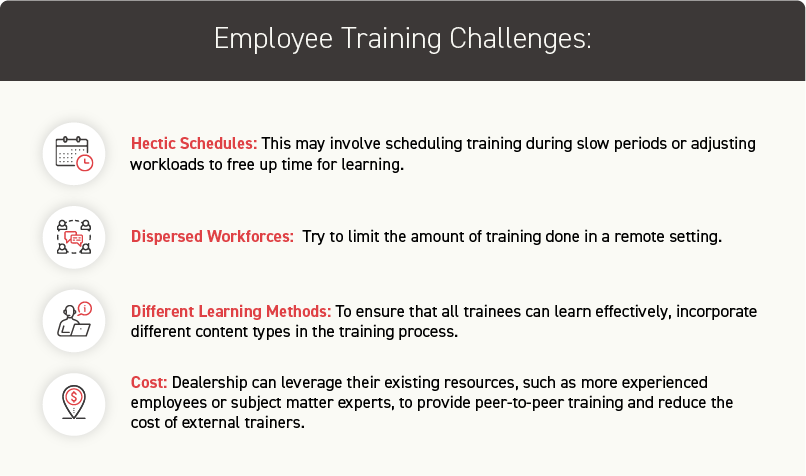
However, there are also challenges, and if the training is not properly monitored or evaluated, it can lead to undesirable outcomes. Some challenges associated with employee training include:
It’s important to recognize that both the trainer and trainee have ongoing job responsibilities and work commitments that need to be fulfilled. Therefore, it’s necessary to have a well-thought-out plan in place to ensure that their regular duties are covered while they engage in training activities. This may involve scheduling training during slow periods or adjusting workloads to free up time for learning.
Try and limit the amount of training that is done in a remote setting. Instead, try to tackle all training face-to-face. This is because it allows for real-time feedback, immediate clarification of doubts, and the building of personal relationships, which can enhance learning outcomes. However, when remote training is necessary, it’s important to use technologies that enable effective communication and collaboration, such as video conferencing, screen sharing, etc.
Employees have diverse learning preferences and may respond better to certain types of content and learning methods than others. To ensure that all trainees can learn effectively, incorporate different content types in the training process. Content types can include written notes, videos, flow charts, etc. Visual learners may benefit from flowcharts, while kinesthetic learners may learn better through hands-on activities or simulations.
Training budgets tend to be small, while demands for training are usually high. It’s crucial to invest in your employees so that you can get a return on that investment in the form of better job performance, increased productivity, and reduced turnover rates. Dealership can leverage their existing resources, such as more experienced employees or subject matter experts, to provide peer-to-peer training and reduce the cost of external trainers.
 Source: https://teamstage.io/employee-retention-statistics/
Source: https://teamstage.io/employee-retention-statistics/
The following is a six-step process for training employees:
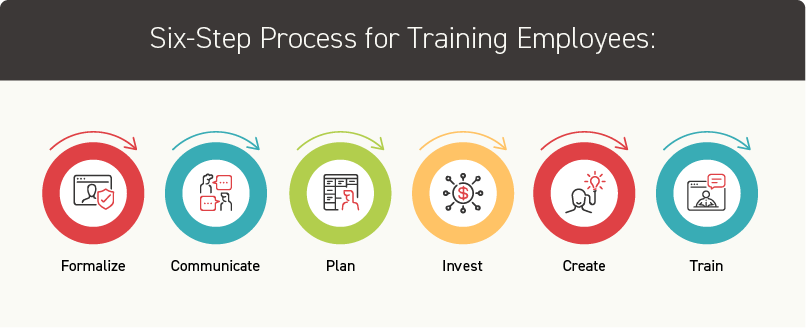
To ensure your peer-to-peer program doesn’t fizzle and become a forgotten initiative, it helps to formalize it by appointing key members in your team that act as your champions for the programs.
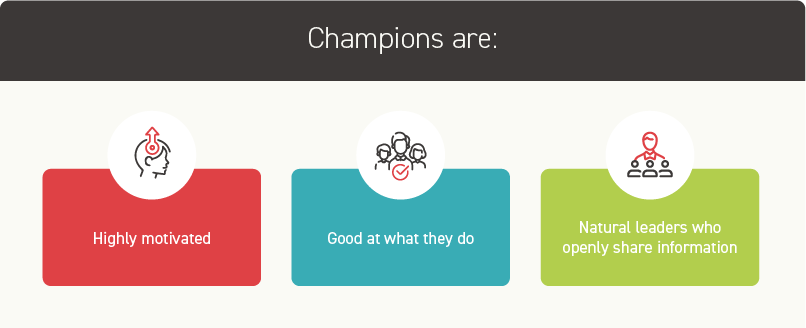
Incentivizing these champions can further motivate them, but it’s important to provide personalized incentives that match their needs and interests, rather than a one-size-fits-all approach. With the right champions, the peer-to-peer program can become a thriving and beneficial initiative for all.
Effective communication is crucial for any business to achieve its goals. By communicating to everyone in the dealership that you are investing in their ability, you are creating a culture that values employee development and growth. This, in turn, leads to a more successful dealership that can meet and exceed its goals.
Incorporating the dealership’s goals into the training plan can also help to align everyone’s efforts towards the same objectives.
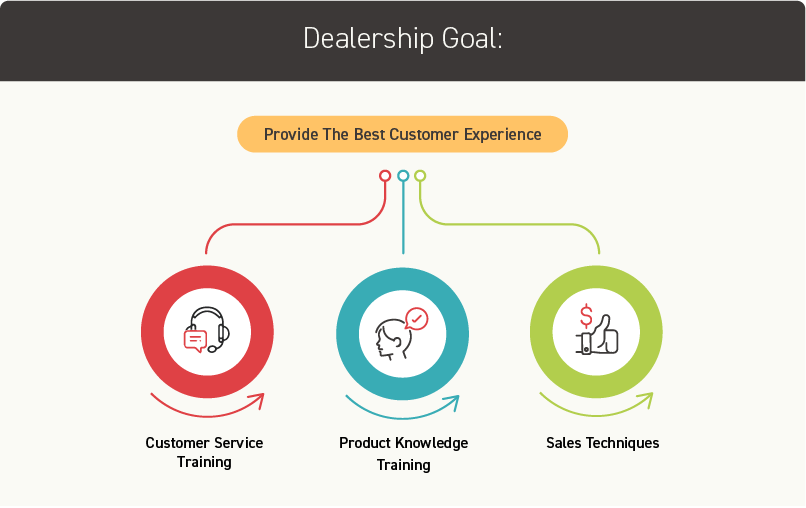
For example, if the dealership’s goal is to provide the best RV or marine experience, the training plan can include modules on customer service, product knowledge, and sales techniques. This will help employees to develop the skills and knowledge needed to meet customers’ expectations and provide an exceptional RV experience.
By aligning the training plan with the dealership’s goals, everyone in the dealership can work together towards a common objective, which can lead to improved performance and success.
READ NEXT: How to Properly Set Up Employee Goals and Expectations
Creating a successful peer-to-peer training program involves careful planning and strategy. To start, it’s important to list out all the positions within your dealership and identify areas that require the most attention or where there are opportunities for quick wins.
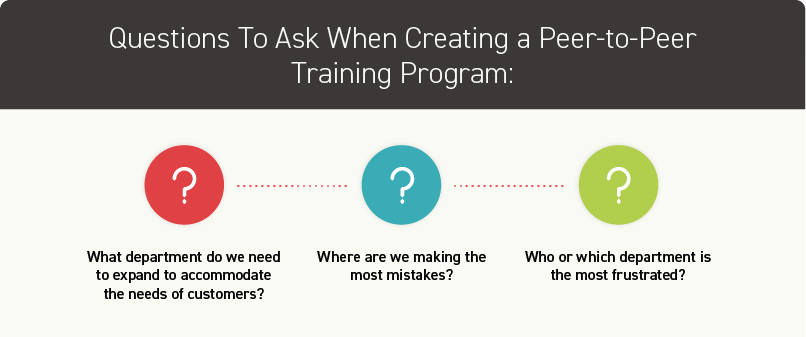
To determine where to focus, ask questions like:
Once you have identified the areas that require attention, you can create a plan that outlines the objectives, training materials needed, and timelines for completion. It should also include details on how training will be delivered and the different content types that will be used, such as checklists, manuals, how-to guides, and even interactive training modules.
Checklists are a simple but powerful tool that can help dealerships streamline their operations and workflow. Checklists can include tasks that need to be done on a daily, weekly, monthly, quarterly, and yearly basis.
One best practice for creating effective checklists is to have a junior associate shadow an experienced employee and create the list together. This not only helps the employee who is shadowing to learn more effectively, but it also ensures that the checklist is comprehensive and accurate.
By creating a shared checklist that everyone can access, employees can easily see what tasks have been completed and what tasks still need to be done. This can help to promote accountability and ensure that everyone is working together towards common goals.
Keep a manual and details on how to complete each of the daily, weekly, monthly, quarterly, and yearly tasks by role. Both the trainer and the trainee should complete the manual to ensure that all important information is included.
By having a manual that details specific processes and procedures, new employees can quickly and effectively learn about their roles and what is expected of them. This will reduce the amount of time it takes for them to become proficient in their roles.
Moreover, having a manual can also help to standardize processes across the dealership. This is important because it ensures that everyone is following the same procedures and that there is consistency in how things are done.
READ NEXT: The Most Important Service Writer Skills and Responsibilities
Effective peer-to-peer training is more about coaching than policing. When trainers act like coaches, they can help employees learn from their mistakes and grow in their roles. Mistakes are bound to happen, and when they do, it’s important to handle them in a way that encourages growth and development rather than discouragement.
The last thing you want is for an employee to feel ashamed or embarrassed for making a mistake.

Trainers should also watch and assist trainees as they complete specific functions. This way, trainers can offer feedback in real time, which can be more effective than feedback given after the fact. Timely feedback helps employees to identify areas of improvement and adjust where necessary. While feedback may not always be comfortable, it is necessary for the success of the training program.
Creating a culture of constructive feedback is vital to any successful peer-to-peer training program. When trainers and trainees are comfortable giving and receiving feedback, it creates an environment where everyone is invested in each other’s growth and development.
Short, one-page guides can also be created for the most common tasks performed by employees in each department. The guides should be concise and easy to understand, providing step-by-step instructions on how to complete each task.
One-page guides can be used in combination with other training materials, such as manuals and checklists, to reinforce the learning process. They can also be easily updated as processes change or new tasks are added, ensuring that employees have access to the most current information.
According to Indeed, soft skills entail a variety of abilities and behaviors that refer to an individual’s non-technical abilities.
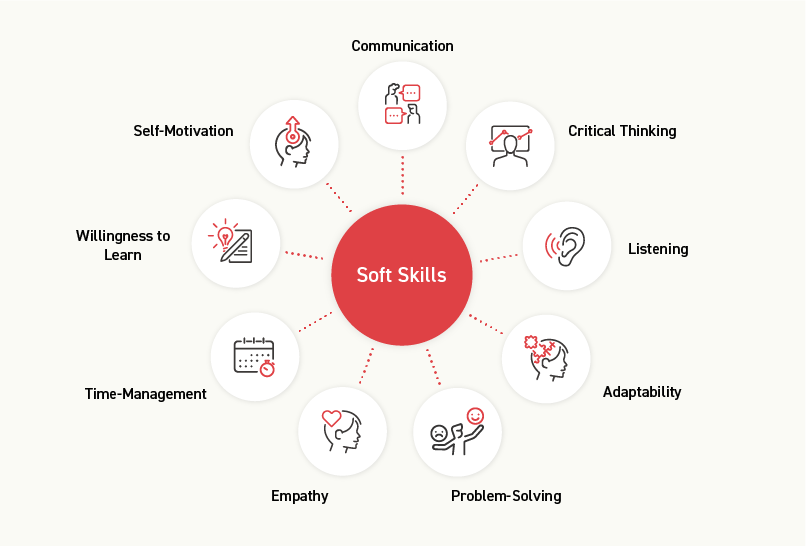
Soft skills are essential to the success of any dealership, but teaching these skills can be challenging. Unlike hard skills that can be taught through lectures, workshops, and hands-on training, soft skills require a different approach.
Not all personalities are the same, and working with different trainees, especially if they are new, could be challenging. Some people are naturally outgoing and confident, while others are more introverted and reserved. An effective trainer needs to be able to recognize these differences and adapt their teaching style to suit the trainee’s personality.
A trainer who can create a safe and supportive learning environment will be more successful in developing the soft skills of their trainees.

A dealership that is committed to taking its employee training to the next level should consider developing a Learning Management System (LMS) that incorporates videos, quizzes, and documentation.
Videos are an effective way to engage employees in the learning process and make it easier for them to understand complex concepts. By visually demonstrating how to perform certain tasks or behaviors, videos can improve the retention and application of the knowledge being taught.
Quizzes are another great way to reinforce the information being taught and to test the knowledge and understanding of the employees as they go through their training. They can also help identify any areas where additional training may be needed.
WATCH THIS: How to Drive Workplace Accountability and Achieve Better Business Results
Peer-to-peer training can be a cost-effective option for dealerships that want to train their teams without incurring high expenses. This is because it doesn’t require hiring an outside consultant or paying for expensive training courses.
Instead, dealerships can leverage the knowledge and expertise of their own employees to create a training program that is tailored to the dealership’s unique needs.
Additionally, peer-to-peer training can help to identify leaders and over-achievers within the dealership. These are the individuals who are highly motivated, knowledgeable, and effective in their roles.
By appointing them as trainers, the dealership can tap into their expertise and use it to train other team members. This can create a sense of pride and recognition among the trainers and motivate them to continue performing at a high level.
While there may be upfront costs associated with setting up a peer-to-peer training program, the long-term benefits can far outweigh the initial investment. It’s a smart and strategic decision that can pay off in the long run.
Get the latest resources sent directly to your inbox.